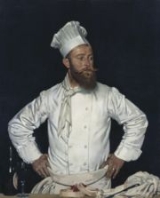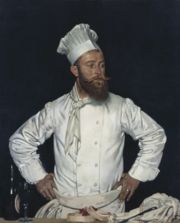
Toque
Encyclopedia
A toque is a type of hat
with a narrow brim or no brim at all. They were popular from the 13th to the 16th century in Europe, especially France
. Now, it is primarily known as the traditional headgear for professional cooks
.
since 1505. It came through the Medieval French
toque (15th century), presumably by the way of the Spanish
toca "woman's headdress", from Arabic *taqaطاقة' 'Opening'.
 A toque blanche (French
A toque blanche (French
for "white hat"), often shortened to toque, is a tall, round, pleated, starched white hat worn by chef
s. The many folds on a toque blanche are believed to signify the many ways that an egg
can be cooked..
The toque most likely originated as the result of the gradual evolution of head coverings worn by cooks throughout the centuries. Their roots are sometimes traced to the casque a meche (stocking cap) worn by 18th-century French chefs. The colour of the casque a meche denoted the rank of the wearer. Boucher, the personal chef of the French statesman Talleyrand, was the first to insist on white toques for sanitary reasons. The modern toque is popularly believed to have originated with the famous French chefs Marie-Antoine Carême
and Auguste Escoffier
.
at British and American universities—is also called a toque.

s of traditional ('royal') heraldry
with a rigorously standardized system (as other respects of 'Napoleonic' coats of arms) of toques, reflecting the rank of the bearer. Thus a Napoleonic Duke
used a toque with 7 ostrich feathers and 3 lambrequins, a Count
a toque with five feathers and two lambrequins, a Baron
three feathers and one lambrequin, a Knight
only one ostrich feather (see Nobility of the First French Empire
).
There is also an unproven theory that the design of the papal tiara
would have been based on a toque.
, worn for riding, especially in equestrian
sports, often black and covered with black velvet
.
 In Canada
In Canada
, toque, or tuque
(icon), is the common name for a knit winter hat. The Canadian English
term was assimilated from Canadian French
tuque. Toque first appeared in writing around 1870.
The fashion is said to have originated with the coureurs de bois, French and Métis
fur traders, who kept their woollen nightcaps on for warmth during cold winter days. Such hats are known in other English-speaking countries by a variety of names, including beanie (American), watch cap or stocking cap; the terms tuque and toque are unique to Canada and northern areas of the United States, close to the Canadian border.
Hat
A hat is a head covering. It can be worn for protection against the elements, for ceremonial or religious reasons, for safety, or as a fashion accessory. In the past, hats were an indicator of social status...
with a narrow brim or no brim at all. They were popular from the 13th to the 16th century in Europe, especially France
France
The French Republic , The French Republic , The French Republic , (commonly known as France , is a unitary semi-presidential republic in Western Europe with several overseas territories and islands located on other continents and in the Indian, Pacific, and Atlantic oceans. Metropolitan France...
. Now, it is primarily known as the traditional headgear for professional cooks
Cook (profession)
A cook is a person who prepares food for consumption. In Germany, Austria, Switzerland and Canada this profession requires government approval ....
.
Etymology
The word Toque is Arabic "طوق" for "Round" and "طاقية" "Taqia" for "Hat" originally for something "Round" that has an opening. The word has been known in EnglishEnglish language
English is a West Germanic language that arose in the Anglo-Saxon kingdoms of England and spread into what was to become south-east Scotland under the influence of the Anglian medieval kingdom of Northumbria...
since 1505. It came through the Medieval French
French language
French is a Romance language spoken as a first language in France, the Romandy region in Switzerland, Wallonia and Brussels in Belgium, Monaco, the regions of Quebec and Acadia in Canada, and by various communities elsewhere. Second-language speakers of French are distributed throughout many parts...
toque (15th century), presumably by the way of the Spanish
Spanish language
Spanish , also known as Castilian , is a Romance language in the Ibero-Romance group that evolved from several languages and dialects in central-northern Iberia around the 9th century and gradually spread with the expansion of the Kingdom of Castile into central and southern Iberia during the...
toca "woman's headdress", from Arabic *taqaطاقة' 'Opening'.
Culinary use

French language
French is a Romance language spoken as a first language in France, the Romandy region in Switzerland, Wallonia and Brussels in Belgium, Monaco, the regions of Quebec and Acadia in Canada, and by various communities elsewhere. Second-language speakers of French are distributed throughout many parts...
for "white hat"), often shortened to toque, is a tall, round, pleated, starched white hat worn by chef
Chef
A chef is a person who cooks professionally for other people. Although over time the term has come to describe any person who cooks for a living, traditionally it refers to a highly skilled professional who is proficient in all aspects of food preparation.-Etymology:The word "chef" is borrowed ...
s. The many folds on a toque blanche are believed to signify the many ways that an egg
Egg (food)
Eggs are laid by females of many different species, including birds, reptiles, amphibians, and fish, and have probably been eaten by mankind for millennia. Bird and reptile eggs consist of a protective eggshell, albumen , and vitellus , contained within various thin membranes...
can be cooked..
The toque most likely originated as the result of the gradual evolution of head coverings worn by cooks throughout the centuries. Their roots are sometimes traced to the casque a meche (stocking cap) worn by 18th-century French chefs. The colour of the casque a meche denoted the rank of the wearer. Boucher, the personal chef of the French statesman Talleyrand, was the first to insist on white toques for sanitary reasons. The modern toque is popularly believed to have originated with the famous French chefs Marie-Antoine Carême
Marie-Antoine Carême
Marie Antoine Carême , known as the "King of Chefs, and the Chef of Kings" was an early practitioner and exponent of the elaborate style of cooking known as haute cuisine, the "high art" of French cooking: a grandiose style of cookery favored by both international royalty and by the newly rich of...
and Auguste Escoffier
Auguste Escoffier
Georges Auguste Escoffier was a French chef, restaurateur and culinary writer who popularized and updated traditional French cooking methods. He is a legendary figure among chefs and gourmands, and was one of the most important leaders in the development of modern French cuisine...
.
Justice
- A toque, or sometimes touge, was the traditional headgear of various French magistrateMagistrateA magistrate is an officer of the state; in modern usage the term usually refers to a judge or prosecutor. This was not always the case; in ancient Rome, a magistratus was one of the highest government officers and possessed both judicial and executive powers. Today, in common law systems, a...
s. - A low type in black velvet, called mortierMortar BoardMortar Board is an American national honor society whose purpose is to recognize outstanding students dedicated to the values of scholarship, leadership, and service. The Cornell University Der Hexenkreis chapter, founded in 1892, is the oldest and predates the national society's founding in 1918...
(also rendered in English as mortar boardMortar BoardMortar Board is an American national honor society whose purpose is to recognize outstanding students dedicated to the values of scholarship, leadership, and service. The Cornell University Der Hexenkreis chapter, founded in 1892, is the oldest and predates the national society's founding in 1918...
), was used by the président à mortierPrésident à mortierThe office of président à mortier was one of the most important legal posts of the French ancien régime. The présidents were principal magistrates of the highest juridical institutions, the parlements, which were the appeal courts....
, president of a parlementParlementParlements were regional legislative bodies in Ancien Régime France.The political institutions of the Parlement in Ancien Régime France developed out of the previous council of the king, the Conseil du roi or curia regis, and consequently had ancient and customary rights of consultation and...
(the royal highest court in a French province), and of the members of two of the highest central courts, cour de cassationCourt of Cassation (France)The French Supreme Court of Judicature is France's court of last resort having jurisdiction over all matters triable in the judicial stream but only scope of review to determine a miscarriage of justice or certify a question of law based solely on points of law...
and cour des comptesCour des ComptesThe Court of Audit is a quasi-judicial body of the French government charged with conducting financial and legislative audits of most public institutions and some private institutions, including the central Government, national public corporations, social security agencies , and public services...
. - A red toque is sometimes worn by German judges, primarily by justices on the Federal Constitutional Court.
Academic
The pleated, low, round hat worn in French universities—the equivalent of the mortarboard or tamTam (cap)
The rastacap is a tall, round, usually crocheted cap, which is often brightly coloured. It is most commonly associated with the pat as a way for Rastafarians and others with dreadlocks to tuck their locks away, but may be worn for various reasons by Rastas and non-Rastas...
at British and American universities—is also called a toque.

Heraldry
In the Napoleonic era, the French first empire replaced the coronetCoronet
A coronet is a small crown consisting of ornaments fixed on a metal ring. Unlike a crown, a coronet never has arches.The word stems from the Old French coronete, a diminutive of coronne , itself from the Latin corona .Traditionally, such headgear is – as indicated by the German equivalent...
s of traditional ('royal') heraldry
Heraldry
Heraldry is the profession, study, or art of creating, granting, and blazoning arms and ruling on questions of rank or protocol, as exercised by an officer of arms. Heraldry comes from Anglo-Norman herald, from the Germanic compound harja-waldaz, "army commander"...
with a rigorously standardized system (as other respects of 'Napoleonic' coats of arms) of toques, reflecting the rank of the bearer. Thus a Napoleonic Duke
Duke
A duke or duchess is a member of the nobility, historically of highest rank below the monarch, and historically controlling a duchy...
used a toque with 7 ostrich feathers and 3 lambrequins, a Count
Count
A count or countess is an aristocratic nobleman in European countries. The word count came into English from the French comte, itself from Latin comes—in its accusative comitem—meaning "companion", and later "companion of the emperor, delegate of the emperor". The adjective form of the word is...
a toque with five feathers and two lambrequins, a Baron
Baron
Baron is a title of nobility. The word baron comes from Old French baron, itself from Old High German and Latin baro meaning " man, warrior"; it merged with cognate Old English beorn meaning "nobleman"...
three feathers and one lambrequin, a Knight
Knight
A knight was a member of a class of lower nobility in the High Middle Ages.By the Late Middle Ages, the rank had become associated with the ideals of chivalry, a code of conduct for the perfect courtly Christian warrior....
only one ostrich feather (see Nobility of the First French Empire
Nobility of the First French Empire
Napoleon Bonaparte created titles of nobility to institute a stable elite in the First French Empire, after the instability resulting from the French Revolution....
).
There is also an unproven theory that the design of the papal tiara
Papal Tiara
The Papal Tiara, also known incorrectly as the Triple Tiara, or in Latin as the Triregnum, in Italian as the Triregno and as the Trirègne in French, is the three-tiered jewelled papal crown, supposedly of Byzantine and Persian origin, that is a prominent symbol of the papacy...
would have been based on a toque.
Sports
Toque is also used for a hard type hat or helmetHelmet
A helmet is a form of protective gear worn on the head to protect it from injuries.Ceremonial or symbolic helmets without protective function are sometimes used. The oldest known use of helmets was by Assyrian soldiers in 900BC, who wore thick leather or bronze helmets to protect the head from...
, worn for riding, especially in equestrian
Equestrianism
Equestrianism more often known as riding, horseback riding or horse riding refers to the skill of riding, driving, or vaulting with horses...
sports, often black and covered with black velvet
Velvet
Velvet is a type of woven tufted fabric in which the cut threads are evenly distributed,with a short dense pile, giving it a distinctive feel.The word 'velvety' is used as an adjective to mean -"smooth like velvet".-Composition:...
.
Canadian usage

Canadian English
Canadian English is the variety of English spoken in Canada. English is the first language, or "mother tongue", of approximately 24 million Canadians , and more than 28 million are fluent in the language...
, toque, or tuque
Tuque
A – variously known as a knit hat or stocking cap among other names – is a knitted cap, originally of wool though now often of synthetic fibers, that is designed to provide warmth in winter...
(icon), is the common name for a knit winter hat. The Canadian English
Canadian English
Canadian English is the variety of English spoken in Canada. English is the first language, or "mother tongue", of approximately 24 million Canadians , and more than 28 million are fluent in the language...
term was assimilated from Canadian French
Canadian French
Canadian French is an umbrella term referring to the varieties of French spoken in Canada. French is the mother tongue of nearly seven million Canadians, a figure constituting roughly 22% of the national population. At the federal level it has co-official status alongside English...
tuque. Toque first appeared in writing around 1870.
The fashion is said to have originated with the coureurs de bois, French and Métis
Métis
A Métis is a person born to parents who belong to different groups defined by visible physical differences, regarded as racial, or the descendant of such persons. The term is of French origin, and also is a cognate of mestizo in Spanish, mestiço in Portuguese, and mestee in English...
fur traders, who kept their woollen nightcaps on for warmth during cold winter days. Such hats are known in other English-speaking countries by a variety of names, including beanie (American), watch cap or stocking cap; the terms tuque and toque are unique to Canada and northern areas of the United States, close to the Canadian border.

